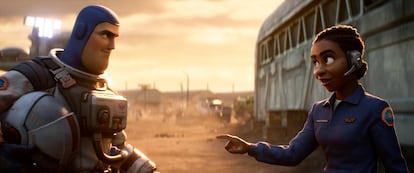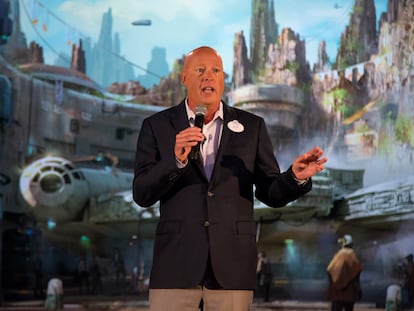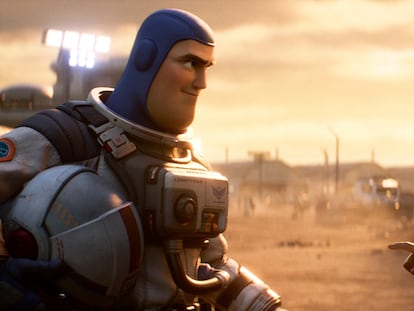Buzz Lightyear: Why the same-sex kiss matters
Thank you, Disney Pixar, for refusing to eliminate the scene between two women and going beyond my wildest dreams when it comes to visibility. In the long run, it is worth the sacrifice at the box office

The first homosexual kiss in a Disney movie has been more than expected. Many of us wanted to see it in Frozen: some interpret the ice princess’s song “Let it Go” as a reference to being gay. Lots of people awaited it in Luca, where the love between protagonists Luca and Alberto was at times more obvious even than that of the cowboys in Brokeback Mountain. We longed for a legendary, effervescent kiss, the fruit of a rebellious and passionate love. It was going to be a vindictive kiss, full of fireworks. It would be one of those kisses that precede the mythical The End, when the screen fades to black behind the lover’s mouths. It was a kiss that was going to take everything over. Above all, it was going to be the great kiss of the 21st century, undoubtedly the century of homosexual visibility and the century of the gender revolution, the moment when women fall in love and kiss for the first time and do all of it on the big screen. (Well, not all of it.)
The first lesbian kiss in Disney history appears in the recently released Lightyear, and it has sadly led to the censorship of the film in 14 countries in the Middle East and Asia. The kiss takes place in 1995, that is, 27 years ago. The first homosexual kiss of the Disney Pixar factory recognizes that it is years late. It is a 90′s kiss. It comes not from the 21st century, but the 20th. How? The film starts with the following premise: in 1995 Andy, the protagonist of Toy Story, went to the cinema to see Lightyear. This is the movie he saw then. Lightyear, therefore, is not the end of the saga but its prequel. In addition, the controversial kiss does not happen between a young protagonist and her girlfriend, but between two mature women who have been married for years. We are not facing a rebellious kiss, much less a political or ideological one. This kiss is not intended to be a novelty or to make anything visible. It is an absolutely conventional gesture. Thank you, Disney Pixar for going beyond my wildest dreams when it comes to normalizing visibility. And thank you for listening to your workers and refusing to remove the scene. In the long run, it will be more profitable to sacrifice box-office earnings than dignity.
In addition to being between two women, the kiss happens between two mothers, on the day that they celebrate their son’s birthday. It is not the classic Disney kiss, a culmination of the romantic love between the leading couple, but a stolen moment of quotidian happiness. It is a fleeting kiss, insignificant in the history of lovers. It lasts just seconds. It is not charged with any special meaning in the love story. It speaks of a way of building affections and meaning different from that imposed by the traditional heterosexual canon: seemingly unimportant gestures of are everything. It represents a kind of love where kisses do not represent a turning point in the lovers’ lives, but rather small anchor points in their story history. In this gesture, romantic love is not ultimately the center of life but part of it. In Lightyear, we witness the anodyne kiss on the lips between space explorer Alisha Hawthorne and her wife, and we realize that partners are not at the center of any story, but rather one of those fragments that give meaning to life. It is a sapphic kiss in the sense that it is another way of building love, more horizontal, quieter and healthier.
Alisha – a female, lesbian and Black – does not have as much screentime as Buzz Lightyear – male, white and the story’s protagonist. She is the protagonist’s friend, confidante and inspiration. Together they are trapped on an uninhabitable planet due to a mistake he made. From that moment on their lives run parallel but radically different–almost like the story of lesbian and heterosexual love. She adapts to the circumstances and begins to live the life that has befallen her, without rejecting its difficulties. The conditions are not the best, but Alisha falls in love – with a woman – and celebrates her luck. Together they have a son. Along the way, she takes care of those she loves, she has a granddaughter, she fights and she investigates. She fills her life with meaning, and she dies. Buzz, on the other hand, insists on “finishing the mission,” “being important,” “saving the world,” “succeeding,” “being a hero,” “doing things alone” and “being the first.” Buzz, who will never know love, embodies many of the traditional values of heteronormative love, starting with the desire for protagonism and the sense of a linear life narrated through love or milestones, leading only to deep, intimate failure.
Lightyear attempts to travel into space to escape from the planet where he is trapped, failing over and over again. Additionally, though, time is altered every time he subjects his ship to hyperspeed. Every time he returns, a few minutes have passed for him and a few years – four, 10 or 20 – for Alisha. He burns through life, while she lives it. In one of the final moments, Buzz Lightyear explains to Alisha’s granddaughter why he and her grandmother became space rangers. “We just wanted to be important,” he says. “Trust me, she was,” she says. And the hero understands that his whole life has been a huge misunderstanding. He will have to return home, knowing that his home is the one he has tried to flee all his life.
The film is a masterpiece, full of action, emotion, humor and imagination. Its commitment to diversity includes a warrior over seventy years old, a rebel whose role is essential in saving the world. No one is talking about the old woman for the simple reason that old age remains invisible even when it occupies the center of the scene. The film also gives us Sox, an adorable robotic cat that demonstrates how the only technology that works is that which helps people, not that which attempts to change them. It is truly one of the great Pixar movies, much more than action and stars.
At this point, it had gotten hard to explain why we humans want to keep going to infinity and beyond. But there is a moment, at the end of the film, when we understand: when the elite protectors of the universe excitedly observe the bronze statue of Alisha, a Black lesbian woman, the source of meaning for humanity, because she is the one who knew how to live a small life with greatness.
Tu suscripción se está usando en otro dispositivo
¿Quieres añadir otro usuario a tu suscripción?
Si continúas leyendo en este dispositivo, no se podrá leer en el otro.
FlechaTu suscripción se está usando en otro dispositivo y solo puedes acceder a EL PAÍS desde un dispositivo a la vez.
Si quieres compartir tu cuenta, cambia tu suscripción a la modalidad Premium, así podrás añadir otro usuario. Cada uno accederá con su propia cuenta de email, lo que os permitirá personalizar vuestra experiencia en EL PAÍS.
¿Tienes una suscripción de empresa? Accede aquí para contratar más cuentas.
En el caso de no saber quién está usando tu cuenta, te recomendamos cambiar tu contraseña aquí.
Si decides continuar compartiendo tu cuenta, este mensaje se mostrará en tu dispositivo y en el de la otra persona que está usando tu cuenta de forma indefinida, afectando a tu experiencia de lectura. Puedes consultar aquí los términos y condiciones de la suscripción digital.











































